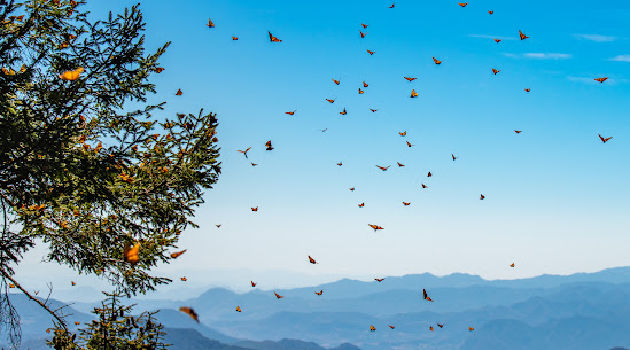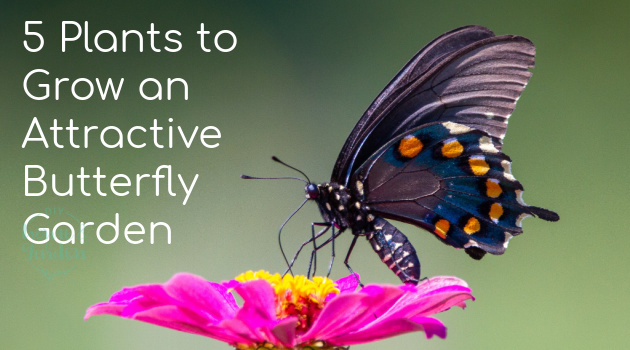Monarch butterflies are a popular species of butterflies primarily due to their vibrant orange colors and distinctive black and white markings.
Interestingly, these insects have a two-way seasonal migration habit—otherwise only observed in birds. Because they can’t survive the Northern climate cold winters, monarchs often rely on environmental cues to discern when it’s time to fly South for the winter.
They use a combination of thermals, air currents, and their magnetic compass to travel long distances, sometimes flying as far as 4,828 kilometers to get to their winter home.
Usually, the monarch family in Western North America settles in California, while those in Eastern North America rest on Mexico’s Sierra Madre Mountains—until the cold season passes by.
Their particular gene for robust and highly efficient muscles (unlike other butterflies) helps propel them throughout long-distance flights.
The Threatened Milkweed Plant and the Decline of the Monarch Butterfly Population
Sadly, these striking black-and-orange beauties have been on a steady and dramatic decline since the 1980s, with the Western monarchs’ reduction rate standing at over 99%.
The Eastern type is estimated to have declined by 80%.
It’s pretty evident that the disappearance of milkweed plays a significant role in the decline of monarch butterflies. Some scientists blame the milkweed decline on climate change. But others blame the overuse of herbicides on the plant.
Besides being their sole breeding zone, milkweed plant leaves are also food to the monarch larvae (better known as caterpillars). In fact, it’s the only thing that the caterpillars eat in this growth stage—the main reason why the females will always lay eggs on the plant.
But with the systematic removal of this plant from fields in recent years and the increased use of herbicides, mowing alongside ditches and roads, the butterflies have been stripped off their breeding habitats, leading to the acute decline in their numbers.
These endangered species would appreciate any efforts to revive their crucial source of sustenance—the milkweed.
Want to attract gorgeous monarchs to your garden? Here is how.
How You Can Attract Monarch Butterflies?
It’s always exciting to watch these beauties flit around flowers to fill up on nectar in summer. But it’s even more thrilling to catch their tiny caterpillars hatching on milkweed and grow bigger each day until they form the green cocoons striped with gold.
Imagine watching the exact moment when the grown monarch takes its first-ever flight!
And now that you can see how much these graceful beauties rely on us for help, you probably want to know even more how to attract monarch butterflies to your garden.
Below are the seven easy tips to boost your success in creating a butterfly garden.
1 – Plant milkweed for monarch butterflies
Planting milkweed is, by far, the best thing you can do to attract and help monarchs.
According to the Penn State University Ag Extension Office, the plant is the most crucial building block in a monarch’s habitat, doubling up as the insects’ breeding spot and the sole source of food for the hatched caterpillars.
Though toxic, monarchs have evolved to tolerate milkweed and use it to their defense.
They feed on the plant and store the toxic chemicals in their bodies to become unpalatable to the predators.
Their predators can easily spot them from afar (thanks to their distinctive color) and avoid them.
Monarchs are naturally drawn to native species of milkweed (those in the Asclepias family), and so, the native A. tuberosa will do. It’s a long-blooming orange perennial, easy to start from seed.
If you’re a pink flower-lover, then you may want to try A. incarnate.
2 – Provide a source of water for “puddling.”
As a nature-lover, you may have noticed butterflies sitting beside streams or in meadows, where the ground is usually muddy.
They often puddle in flutters to sip vital minerals from the damp spots using their proboscis—a long hollow tube (almost likened to a straw) that curls and uncurls.
To attract more butterflies to your yard, consider adding a water source to your flower garden, mimicking their natural preferences—moist or damp ground.
Butterflies won’t land in the water to puddle; instead, they’ll congregate around the damp edges near the water source.
How to make a butterfly puddler:
- Use a shallow dish or pan—a pie tin or a terracotta plant saucer will do.
- In a sunny location (free of strong winds), dig a shallow hole so the container sits recessed.
- Bury the container to its rim, then fill it up with gravel or sand.
- Sprinkle thoroughly with water, so it becomes damp and top off with water. You’ll have to water the puddle often, especially in hot weather, to keep it wet.
Alternatively, if you use drip emitters to water your garden, consider positioning a section of the emitter over the puddler; or let your outside faucet drip slowly into the butterfly puddler.
- Add beneficial minerals and salt.
Ideally, butterflies (especially the male) visit puddles searching for salt and other minerals and not necessarily water. This is because the nectar they suck from flowers supplies a significant portion of the moisture they need to stay hydrated.
Therefore, once you’re done making the puddling pool, sprinkle some salt on it occasionally, add leaves or manure compost, or overripe fruit (with a bias to oranges and bananas) from time to time, so the butterflies can readily get the salt and nutrients they need.
3 – Plant shrubs where monarch butterflies can hide from predators
Planting native shrubs will do more than just hiding the butterflies from predators.
Most native plant species have a timely succession trend of producing nectar-rich blooms from spring through to fall—readily supplying the monarchs’ needs for nutritious feed as they breed (in spring and summer) and migrate in fall.
The trees and shrubs’ leaves also shelter the butterflies in stormy weather and offer them shade to cool their bodies when it gets hot.
However, you don’t want to end up with just a single type of bloom (with similar colors) and so incorporate other plantings as well with varying flower colors and different blooming seasons, so the monarchs have an easy time targeting the nectar source of their choice.
It will also make your garden look more natural and beautiful while still serving its intended purpose all year round.
Native plants require very minimal maintenance and so don’t dread growing them.
4 – Colorful flowers attract the monarch butterfly.
It’s not only the type of plant that draws the attention of monarchs but also the blooms.
Monarchs love yellow, red, pink, orange, and purple blossoms, and especially those that are flat-topped and exhibit short flower tubes.
Other than milkweed, you can grow in a few more flowering plants like verbena, cosmos, buddleia, zinnias, Siberian wallflower, salvia, and chives.
5 – Place smooth rocks in the garden.
Butterflies enjoy the warmth, primarily relying on the heat from the sun to regulate their body temperatures.
And so, adding flat smooth rocks alongside other heat retentive materials in the sunny spots of your garden or yard will offer them a place to rest and spread open their wings, to soak in on the sun’s heat for energy.
6 – Skip the harmful insect control chemicals
With the rising and widespread use of herbicides, many insects risk total wipe-out.
When used in gardens, chemical insecticides kill and keep away even the beneficial insect pollinators, butterflies included.
To make your garden monarch-friendly, consider using only organic weed and pest control methods that guarantee their safety.
7 – Plant a monarch butterfly garden in partial sun
Butterflies are ectothermic (cold-blooded). Therefore, they rely on behavioral instincts to warm themselves up so they can fly.
One way they do this is by basking in the sun—the main reason why your garden should be located in a partially sunny location so that the insects maximize on the sunlight.
The Bottom Line: The Monarch Butterflies Need Our Help
We humans tear apart their habitat. If we are not careful, these beauties could disappear forever. Still, these butterflies play a very crucial role in plant pollination.
The most effective way to rescue and support the sharply declining monarch population is to build back their habit, to plant a butterfly garden with milkweed and other nectar-rich plants.
Perhaps you already have a garden for them, which of course, they appreciate. Just ensure you’re always on the lookout when moving stuff around in your yard/garden or collecting fallen branches.
Sometimes the chrysalises face the danger of being damaged because they’re too exposed. It could be some strong wind that dislodged them from the object they were attached on, or they just fell in harm’s way—like on a car’s tire.
You may want to relocate the chrysalises to a safer place, so they hatch successfully. However, first, make sure that they’ve hardened off because fresh chrysalises are pretty delicate to handle.
Check to see if it’s opaque green or it has begun turning transparent, so you’re able to see the monarch inside.
Usually, the monarch’s pupation stage takes ten to fourteen days, with the chrysalises hardening after one or two days.
With our care for their habitat, we can save the monarch butterflies. Once you attract them to your yard, you will find them entertaining for hours on end.



